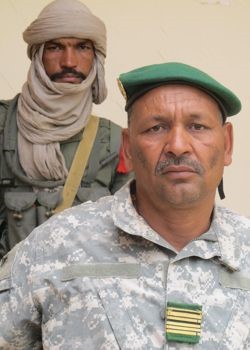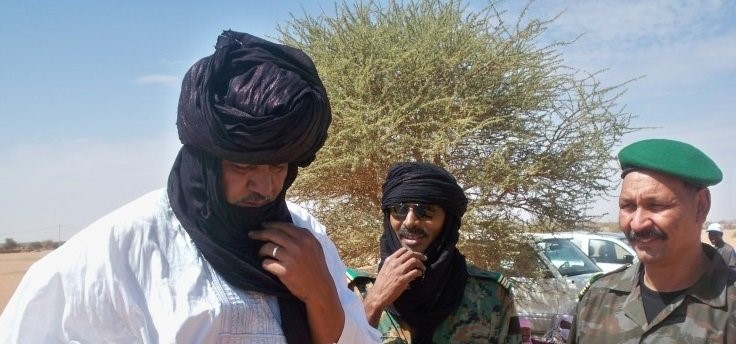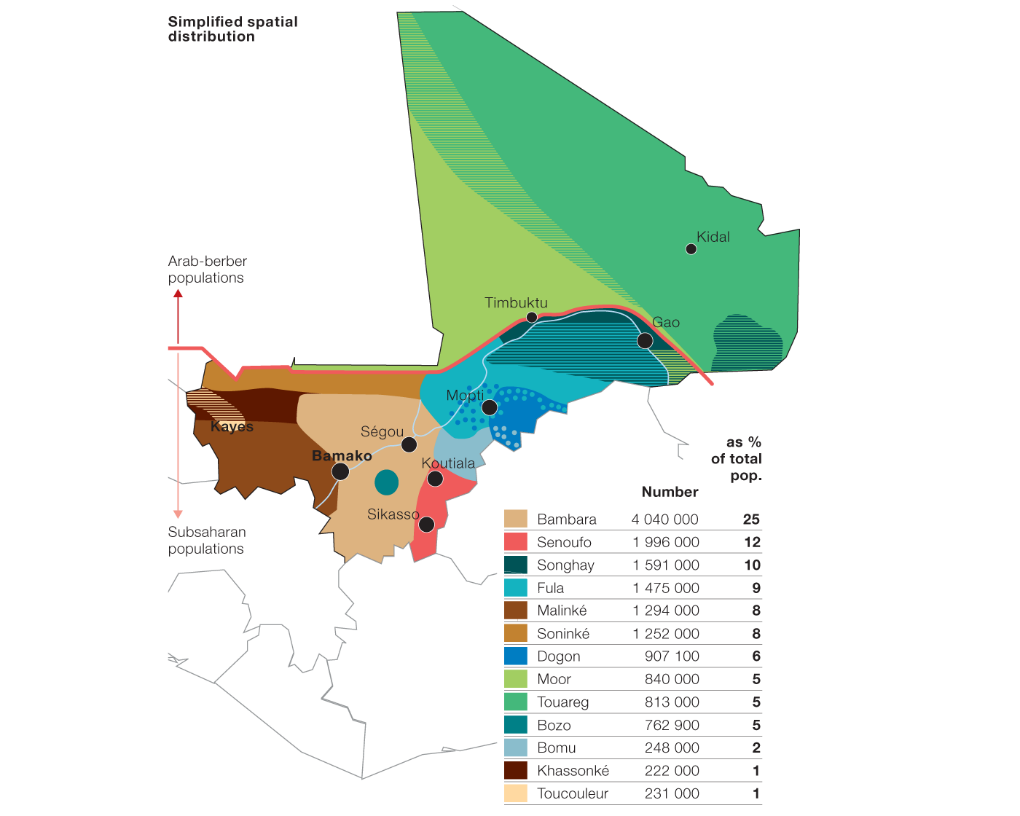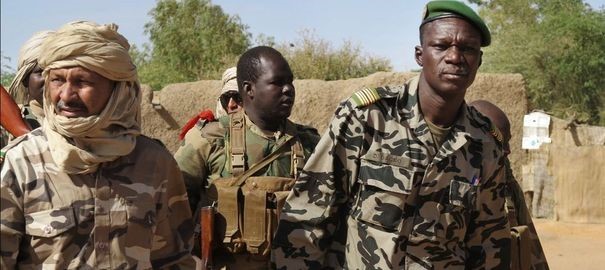Andrew McGregor
Aberfoyle International Security
December 1, 2016
With a small population of roughly 2 million people spread as tiny minorities in five African states, the survival of the Berber Tuareg might appear to rely necessarily on ethnic solidarity. This, however, has never been the case with the Tuareg, who nurture often violent differences between confederations, tribes, clans and social classes. It was these differences, in part, that prevented the Tuareg from mounting an effective, unified opposition to the consolidation of their territories under French colonial rule in the late 19th/early 20th centuries. While the Tuareg gained a reputation as perpetual rebels to colonial rule, this perception ignored the Tuareg confederations that aligned themselves with the French and assisted the expansion of their empire in Africa.
In similar fashion, modern Tuareg rebels and separatists in northern Mali have been the focus of international media in recent years, but there are Tuareg groups and leaders who see their future in a united Malian state. One such leader is known as Le Renard de Kidal, the “Fox” of Mali’s north-eastern Kidal region, the desert home of some of Mali’s most committed rebels. The Fox is General al-Hajj ag Gamou, loyal to the Bamako government and the first and only Tuareg member of Mali’s general staff.
 General al-Hajj ag Gamou (Le Figaro)
General al-Hajj ag Gamou (Le Figaro)
With over three-and-a-half decades of active military life behind him, ag Gamou enjoys intense loyalty from the men in his command, many of whom have been with him for years. As one NCO put it: “Gamou, he eats with us, he fights with us. Despite his rank, he remains simple. This is a good warrior. One wants to be like him” (Bamada.net, June 27, 2013).
Now, as both an officer in the Malian Army and the leader of a powerful and personally dedicated desert-based militia, ag Gamou finds himself at the center of a social upheaval in the Tuareg world that has become inextricably tangled with the still-simmering rebellion of Arab and Tuareg separatists in Mali’s Kidal region.
From Shepherd to Soldier
Born in 1964 in Tidermène (Ménaka district), al-Hajj ag Gamou worked with his father herding goats instead of attending school. Like his father, ag Gamou is a member of the Imghad, a Tuareg group who act as hereditary vassals to the smaller but “noble” Ifoghas group in northern Mali’s traditional Tuareg hierarchy. [1]
As a 16-year-old, ag Gamou left drought-ridden Mali to join Libya’s Islamic Legion, a largely unsuccessful 1972-1987 attempt by Mu’ammar Qaddafi to create a multinational elite Arab fighting force to further his pan-Arabist policies. Relying on unsound historical and linguistic contortions designed to prove the Berber Tuareg were actually Arabs, Qaddafi recruited heavily from Tuareg communities in the Sahel. [2] Poorly trained and often reliant on impressed migrant workers to fill its ranks, the Legion never achieved elite status and performed poorly against French-supported Tubu warriors on its main battlefield, Chad. Nonetheless, the young ag Gamou received Special Forces training in Syria before fighting alongside Palestinians in Lebanon’s civil war and later in Qaddafi’s attempt to seize northern Chad, believed at the time to be uranium-rich (L’Opinion [Paris], June 9, 2014). By the time the Legion was dissolved, ag Gamou had likely been well exposed to Qaddafi’s belief that the tribes of the Sahel should reject the region’s traditional social hierarchies
Similar ideas were forming in northern Mali. Like the earlier colonial French, Mali’s post-independence government continued to rely on the powerful Ifoghas Tuareg to assert authority over other Tuareg groups in northern Mali in the name of the government. However, the absence of state institutions in northern Mali meant an absence of development, infrastructure, health care, security and employment, all encouraging an illicit smuggling-based economy and a cycle of rebellion and temporary reconciliation when one or both sides were exhausted.
When democracy was introduced with independence in 1960, members of lower social orders in Arab and Tuareg society such as the Imghad were able to use their greater numbers to place their representatives in positions of authority over the local “noble” clans. The rejection by these clans of any social restructuring has been a core issue in nearly every rebellion in northern Mali since independence.
Return to Mali and Rebellion
After the Libyan defeat in Chad, ag Gamou returned to Mali, where he became involved in the Libyan-supported 1990-1996 Tuareg rebellion as a leading member of the Libyan-supported Armée Revolutionnaire de Libération de l’Azawad (ARLA). French historian Pierre Boilley met ag Gamou in those days and described him as “a taciturn and secretive man. He did not make grand speeches. He could get brutally excited, but he was pleasant” (Bamada.net, June 27, 2013). As usual, the Tuareg failed to unite in a common cause and ag Gamou’s ARLA became engaged in a violent rivalry with Iyad ag Ghali’s Mouvement populaire de l’Azawad (MPA). Ag Gamou had served alongside ag Ghali, an Ifoghas, in the Islamic Legion.
In February 1994 ag Gamou made a strategic mistake by kidnapping Intallah ag Attaher, the amenokal (chief) of the Ifoghas of Kidal. Though the amenokal was eventually returned unharmed in a prisoner exchange, the event was viewed by many Ifoghas as an unforgivable assault on the traditional social order and led to ARLA’s military defeat. Over two decades later the event still has repercussions – Intallah ag Attaher’s eldest son, Mohamed ag Intallah, is the new amenokal, while another son, Alghabass ag Intallah (the former right-hand man of Iyad ag Ghali in Ansar al-Din) is now head of the HCUA, an Ifoghas dominated militant group based in Kidal. Neither have forgotten the kidnapping, which continues to poison relations between the Imghad and the Ifoghas.
 Mohamed ag Intallah with al-Hajj ag Gamou (Maliweb.net)
Mohamed ag Intallah with al-Hajj ag Gamou (Maliweb.net)
An End to Rebellion
As the rebellion wound down, Gamou joined other rebel fighters integrating with the Malian army. Integration allowed for further military training at the Koulikoro military school and deployment to Sierra Leone as a peacekeeper in 1999 (for which he was decorated) before assignment to Gao in 2001. His services resulted in promotion to lieutenant colonel and eventual command of the Kidal region in 2005. Gamou once explained his decision to become a government loyalist: “With the [1990-96] rebellion, we have obtained what we sought. Me, I have not been to school and I am a Colonel-Major. Why take up arms?” (Bamada.net, June 27, 2013).
The 2007-2009 Tuareg rebellion found Gamou on the government side in a bitterly fought campaign against Ibrahim ag Bahanga’s Alliance Touareg nord Mali pour le Changement (ATNMC). The tide turned against the rebels in 2009 when joint operations between Gamou’s Tuareg Delta militia, Colonel Muhammad Abd al-Rahman Ould Meydou’s Arab militia and Special Forces units of the Malian regular army (Echelon tactique inter-armes – ETIA) swept rebel bases in the north and drove the insurgents into Algeria. [3] Gamou’s work in the campaign brought him an appointment to President Amadou Toumani Touré’s personal staff despite concerns he was increasingly involved in northern Mali’s lucrative smuggling industry.
The Grand Deception
Many Malian Tuareg fought for the Qaddafi regime during the 2011 Libyan revolution. As the regime crumbled, ag Gamou was put in charge of welcoming these fighters back and urging their integration into the Malian Army, but the only takers were fellow Imghad (L’Aube [Bamako], February 18, 2016). The others quickly formed new armed movements, most notably the separatist Mouvement national de libération de l’Azawad (MNLA) and the Islamist Ansar al-Din, led by ag Gamou’s rival Iyad ag Ghali.
When a January 24, 2012 joint MNLA-Ansar al-Din rebel attack on Aguelhoc resulted in the massacre of its mostly southern-origin garrison after their ammunition ran out, ag Gamou rushed north from Kidal only to find the attackers had withdrawn. Small-scale clashes continued for two months after the rebellion began, when ag Gamou found his 500-man force surrounded and cut off from escape routes by a combined rebel force. After the Aguelhoc massacre surrender did not appear to be an option for the 200 southern troops under his command, while Iyad ag Ghali had already made his desire to slay ag Gamou well known. With the collapse of the Malian Army and a military coup in Bamako, there was no chance of relief from the south. Ag Gamou now made a shocking announcement – he had decided to go over to the rebels:
I changed sides because the Malian government has great difficulties in assuring the army’s defense of territory… Today I am dejected both physically and morally. Since I joined the Malian Army, I vowed to never betray it. But, today, I feel I am worn out. I fought as best I could with the means available to me. Against heavily armed men and a state that could not support me in my fight, I could not find a solution that could save us, me and my comrades (L’Indépendant [Bamako], April 2, 2012).
Contacting the MNLA’s Colonel Assaleth ag Khabi, ag Gamou agreed to join the rebel movement in exchange for protection from Iyad ag Ghali. The southern troops were disarmed and the MNLA demanded their handover, but Gamou refused, saying they were now his hostages. Granted freedom of movement by the rebels, Gamou headed for Niger and reported to the Malian consul in Niamey that his men were still loyal and ready to be repatriated to Bamako (Jeune Afrique, April 11, 2012; Bamada.net, June 27, 2013 ). The ruse had saved his command and left the rebels fuming.
A quick return to Bamako, however, was impossible. Mali’s army had abandoned the north, overthrown the president and was now consuming itself in bitter street battles between outnumbered Touré loyalists (the “Red Berets” of the presidential guard) and American-trained “Green Beret” putschists under Captain Amadou Sanogo. As Islamist militants poured into northern Mali, sidelining the politically secular MNLA, ag Gamou and his men were forced to watch helplessly from Niger: “It was very hard, very hard to be in a foreign country for a year” (France24.com, May 2, 2013). On December 2, 2012 an al-Qaeda operative attempted to kill ag Gamou in Niamey, but a potentially lethal shot was deflected by the commander’s cell-phone.
 Tribal Map of Mali (Source: “Atlas Jeune Afrique 2010,” in: Bossard, L. (ed.), An Atlas of the Sahara Sahel, OECD, Sahel and West Africa Club, 2015, p. 191).
Tribal Map of Mali (Source: “Atlas Jeune Afrique 2010,” in: Bossard, L. (ed.), An Atlas of the Sahara Sahel, OECD, Sahel and West Africa Club, 2015, p. 191).
Return and Revenge
The launch of the French-led Operation Serval to retake northern Mali in January 2013 provided the opportunity for Ag Gamou’s fighters to join a column of Nigerien and Chadian troops crossing into northern Mali to link up with French forces advancing from the south. Ag Gamou helped drive Islamists of the Movement for Unity and Jihad in West Africa (MUJWA) from Gao and loaned guides who provided invaluable services to Chadian and French troops fighting in the rocky and forbidding Adrar des Ifoghas region north of Kidal. However, the rivalry with the MNLA persisted, and Gamou found himself recalled to Bamako in March 2013 after arresting three MNLA members in Kidal who were aiding French forces in Operation Serval.
After the campaign, ag Gamou was decorated and elevated to the rank of brigadier general by a new unity government on September 18, 2013 (Le Débat [Bamako], January 3, 2014). MUJWA had not forgotten him however, and took their revenge on November 18, 2013 by murdering two members of his family (including a 3-year-old girl) and wounding two others (L’Indépendant [Bamako], November 25, 2013).
Assault on Kidal
Despite the expulsion of the foreign Islamists, the situation in the north remained tense with many fugitive Tuareg Islamists from Ansar al-Din transferring their loyalty from ag Ghali to a new and more politically acceptable movement, the Haut conseil pour l’unité de l’Azawad (HCUA). Despite all advice to the contrary, Prime Minister Moussa Mara insisted on visiting Kidal on May 17, 2014 to assert Malian sovereignty. Protesters prevented his plane from landing, so he arrived by helicopter. Ag Gamou and 60 of his men accompanied the PM’s convoy into the rebel stronghold, increasing local anger (Jeune Afrique, June 10, 2014).
Fighting broke out almost immediately between the Malian garrison and elements of the MNLA, HCUA and the separatist faction of the Mouvement arabe de l’Azawad (MAA), forcing Mara to seek protection in the MINUSMA (Mission multidimensionnelle intégrée des Nations unies pour la stabilisation au Mali) peacekeepers’ camp outside of town. By the 19th, government reinforcements began arriving, including troops freshly trained by the European Union.
On May 21 a government offensive on Kidal led by the 33rd Para-Commando Regiment (the “Red Berets”) and supported by BRDM-2 armored patrol cars and Malian infantry (the “Green Berets”) appeared to go well until the rebels launched a three-pronged counter-attack in the early afternoon. Mistakenly thinking the Paras had been destroyed, the Green Berets fled, with many soldiers and officers taking refuge in the MINUSMA camp outside the city (the 1200 peacekeepers and 100 French troops at the camp took no part in the fighting). After taking heavy losses, the Paras were forced to surrender, leaving Kidal firmly in rebel hands. Ag Gamou’s men were pursued southwards, with the commander’s right-hand man, Colonel Faisal ag Kiba, killed in the retreat. Panic spread as far as Gao and Timbuktu while Malian troops fled other towns without firing a shot, taking refuge in MINUSMA camps or even fleeing across the border into Algeria (Maliactu.net, February 24).
In Bamako, new President Ibrahim Boubacar Keïta fired Defense Minister Soumeylou Boubeye Maiga and denied ordering the offensive (L’Opinion [Paris], June 9, 2014). Ag Gamou’s role as one of the three leaders of the offensive (along with Brigadier Didier Dacko and Colonel Abdoulaye Coulibaly) resulted in a serious but apparently temporary blow to his military prestige. With both the army and its militia allies recognizing that the military required a field general as chief-of-staff rather than an “office general,” Arab and Fulani militia leaders at the Ouagadougou peace talks recommended ag Gamou as new chief-of-staff to replace General Mahamane Touré, who resigned following the Kidal affair (Maliweb, May 29, 2014). [4]
The Formation of GATIA
Imghad leaders observed that only armed groups were invited to the peace negotiations and decided to form their own in August 2014, the Groupe d’autodéfense des touareg Imghads et allies (GATIA). According to a statement issued by the movement, GATIA “was created… to protect the Imghad people and their allies who have been abandoned by the state in an area where there are armed groups that kill and humiliate with impunity” (Africa News/Reuters, August 29).
The pro-Bamako GATIA began successful operations against the MNLA in October 2014. Ag Gamou’s role as GATIA leader was initially unacknowledged, but he appeared to use a 2016 Facebook posting to remove all ambiguity: “I am from GATIA. I have never hidden it,” adding “Mali will never be divided; I am Malian. So long as I live, the conspirators will never achieve their aims. And after my death, I have trained men to defend the territorial integrity of Mali” (Le Malien [Bamako], September 23). [5]
A proliferation of armed groups in the north made negotiations almost impossible, so most groups agreed in June 2014 to align themselves to either a pro-government coalition (La Platforme) [6] or an opposition coalition (Coordination des mouvements de l’Azawad – CMA). [7] The general view in southern Mali is that the CMA is “feudal, anti-republican and anti-democratic” (Koulouba.com, August 1, 2016). As tensions increased between the two coalitions, GATIA set up checkpoints at the northern and southern entries to Kidal in mid-June 2016.
Ten people were killed on July 22 in fighting between GATIA and the CMA that some believed was a struggle for control of the smuggling trade (Maliactu.net, August 10). UN human rights observers and MINUSMA aerial surveillance recorded forced displacements and even executions of rival clansmen by GATIA elements, though a GATIA spokesman explained these as the result of “intercommunal tensions” (Reuters, August 31, 2015).
A series of clashes followed through the summer as the CMA attempted to break the GATIA blockade. After a September 16 battle at In Tachdaïte, a MNLA official claimed ag Gamou’s fight against the Ifoghas was only a pretext designed to gather popular support for his true purpose – establishing government control of areas now held by the CMA while using his growing military importance and political influence to protect trafficking networks. The official went on to say that peace with ag Gamou would be impossible as all his officers were drug traffickers using arms from government arsenals to control drug routes (Journal du Mali, September 22). GATIA in turn claims that CMA figures are involved in drug transports; in reality there are few Tuareg and Arab gunmen in northern Mali who are not involved in some type of smuggling, the only lucrative work available.
Despite reverses in Kidal itself, GATIA continues to maintain an effective blockade of the city that makes life there difficult (L’Indicateur du Renouveau [Bamako], September 21). GATIA will not allow humanitarian aid to cross into Kidal unless it is associated with its distribution. Air transport is not an option as the airport is closed due to a proliferation of land-mines (Reuters, October 17).
GATIA’s activities have drawn the ire of the U.S.; American ambassador to Mali Paul Folmsbee recently demanded that Bamako “put a stop to all ties both public and private with GATIA, a group of armed militia that is not contributing to the north” (Africa News/Reuters, August 29). U.S. ambassador to the UN Samantha Power similarly called for Bamako to “cease all supports to groups that are subservient to it,” while deploring the involvement of a Malian general (ag Gamou) who “continues to lead a northern militia” (L’indicateur du Renouveau [Bamako], October 3).
 Ag Gamou (left) with General Didier Dacko (right)
Ag Gamou (left) with General Didier Dacko (right)
Mali’s army chief-of-staff, General Mahamne Touré, was replaced by on June 29 by his deputy, Brigadier Didier Dacko, who was at the same time promoted to Major General (L’Essor [Bamako], July 8; Jeune Afrique, July 18). Dacko, a member of the Bobo tribe (a group straddling the border with Burkina Faso), has a reputation as a fighting officer and has worked closely with Gamou on many operations. The change suggests GATIA will continue to be able to rely on the Malian Army for funds and weapons.
Conclusion: An Obstacle to Peace?
Ag Gamou once declared: “I have no political ambition. I am a soldier; soldiers are outside of politics. I am here to defend the territorial integrity of Mali… Politics does not interest me. Not at all” (RFI, March 6, 2013). Nonetheless, many in Mali now suspect Gamou’s involvement with GATIA reflects growing political ambitions. Bamako’s inability and/or reluctance to establish central control over northern Mali has left the region open to the rule of local strongmen, particularly if such individuals have the advantage of reflected legitimacy through an official role in the national armed forces. Politically, however, Gamou does not enjoy President Ibrahim Boubacar Keïta’s trust in the way Amadou Toumani Touré trusted him. Western diplomats may regard ag Gamou as an obstruction to a negotiated settlement in the north, but for many in the region this professional soldier represents the face of a new social order no longer based on a hereditary hierarchy.
Notes
- For the Imghad, see Baz Lecocq, Disputed Desert: Decolonisation, Competing Nationalisms and Tuareg Rebellions in Northern Mali, Brill, Leiden, 2010, pp.6-7.
- Lieutenant Colonel Kalifa Keita, Conflict and Conflict Resolution in the Sahel: The Tuareg Insurgency In Mali, Strategic Studies Institute, Carlisle PA, May 1, 1998, p.13
- See US Embassy Bamako Cable 09BAMAKO538_a, August 12, 2009, https://wikileaks.org/plusd/cables/09BAMAKO538_a.html
- General Touré was eventually retained in the post and made his official retirement on December 31, 2015.
- The authenticity of this statement was challenged by GATIA’s secretary general (Jeune Afrique, September 23, 2016).
- The coalition was formed June 14, 2014, and includes GATIA, the MAA-Platforme, the Coordination des mouvements et fronts patriotiques de résistance – CMFPR (a mainly Songhai and Fulani/Peul group) and the Mouvement pour le salut de l’Azawad (MSA), a Tuareg MNLA splinter group that opposes Ifhoghas domination of the Kidal region and joined La Platforme on September 17, 2016.
- The CMA was formed June 9, 2014. The coalition includes the MNLA, HCUA, MAA-Dissident, CMFPR II and the Coalition pour le peuple de l’Azawad (CPA), a largely Tuareg MNLA splinter group that favors federalism over separatism.
